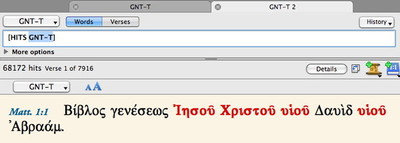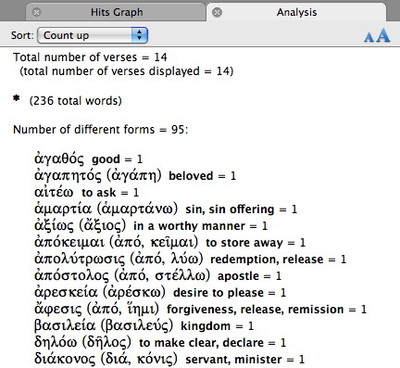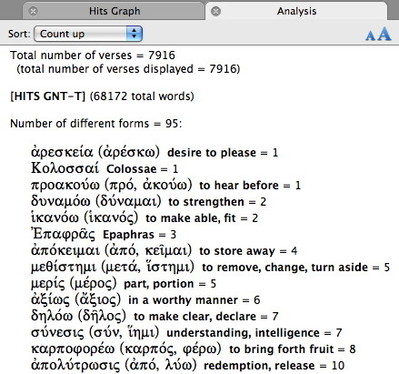A few weeks ago, I made the claim that whenever you ask us if you can do something using Accordance, we’re usually able to answer with a simple and straightforward, “Yes you can!”. Not long after that, I backed that up by answering “Yes you can” to a specific challenge. A few days ago, someone posted the following question in response to that second post.
Thanks, David. This has inspired me to play around a bit with the analysis window and its options.
Is there a way to see words from a particular pericope listed in order of the frequency with which they occur in the whole NT? For instance, could one get a list of the words in Col 1:1-14 from the most rare (in the NT, not in the pericope) to the most frequently occurring? I can’t quite figure out how to automate this in Accordance.
Wait for it: . . . Yes you can! And of course, it’s easy to do. Here’s how:
The first thing we need to do is find every word in Colossians 1:1-14. I’ll be doing the search in the tagged Greek New Testament (GNT-T), but you can do it in an English translation as well. To search for every word in a passage, simply click the Words button, enter the asterisk wildcard (*) to represent any word, then use the AND and RANGE commands to limit your search to a particular passage. Both the AND and RANGE commands are listed in the Enter Command submenu of the Search menu, or you can use the keyboard shortcuts shift-command-A and shift-command-R. Your search argument should then look like this:
After doing this search, every word in Colossians 1:1-14 will be highlighted. What is the point in that? Well, having found every word, you can now analyze the words that were found or even use them as the basis of another search.
If you click the Details button and look at the Analysis tab, you’ll see a listing of every word that was found and the number of times it appears. To sort these from least frequent to most frequent, simply choose Count Up from the Sort pop-up menu. Your analysis should look like this:
This is close to what the user requested, except that she wanted to see the words listed according to their frequency in the entire New Testament rather than just the passage in question. What’s the difference? Well, as you can see here, the word αγαθος (“good”) is only used one time in Colossians 1:1-14. Yet αγαθος is hardly a “rare” word in the Greek New Testament. To see which of these words is least common in the Greek New Testament, we will have to do a new search for each of these words in the entire New Testament!
Thankfully, we don’t have to search for each of the 95 different words in Colossians 1:1-14 separately. Instead, we can use the entire list of words as the basis of a new search. To do that, duplicate the existing Search window by using the keyboard shortcut command-D. Hit the tab key once to select the entire contents of the argument entry box, then select HITS from the Enter Command submenu of the Search menu (or use the keyboard shortcut shift-command-H). If you only have the two tabs I’m describing, when you enter the HITS command, it should automatically insert the name of the tab containing your first search. If you have additional search tabs open, a dialog box will appear asking which tab’s “hits” you want to use.
What does the HITS command do? As its name suggests, it lets you use all the “hits” (that is, found words) from another search as an argument in a new search. In this case, we’re searching for every occurrence of each word found in Colossians 1:1-14, but since we’ve set no range for this search, we’ll now find those words throughout the entire GNT.

When we click the Details button and look at the Analysis tab of this search, we can now Count Up to focus on the truly unusual words in Colossians 1:1-14.
While I’ve taken a long time to explain all this, performing this search and getting the analysis actually takes no more than a few mouse clicks. The trick is knowing that the HITS command lets you use the hits from one search as the basis for another. Learn to use the HITS command, and you’ll discover many more “Can I?” questions for which the answer is . . . say it with me . . . “Yes you can!”




